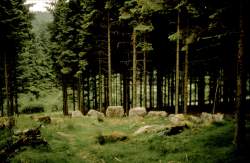
The forest and woodland cover in Britain today is greater than it has been for a considerable period of history. There are many archaeological sites that were once located in an open landscape but are now surrounded by trees.
Sites vary considerably in size and appearance, ranging from extensive field systems or hill forts, to single standing stones or sites of artefact finds. By their very nature, earthworks are the most commonly known, with sites of buried (or less dramatic) evidence being harder to identify on the ground.
In some circumstances, where a feature is believed to have originated in an open landscape, there may be a case for modifying the forest design plans to eventually remove the trees from the immediate surroundings. On many sites, this has been successfully carried out and features returned to an open setting. However, there are many possible implications of tree removal for both the long-term management of the archaeological site and the remaining woodland. These must be considered prior to any clearance.
Where there is no past relationship between the archaeological feature and the wooded environment in which it now occurs, it may be referred to as archaeology in woodland.